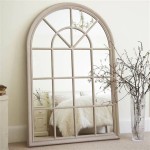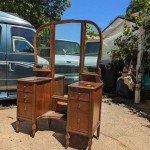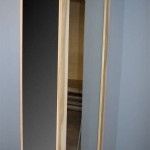Mirror On Dining Room Ceiling: Aesthetics, Functionality, and Installation Considerations
The incorporation of a mirror on a dining room ceiling is a design choice that can significantly impact the ambiance and perceived space of the room. This architectural feature, while not ubiquitous, offers a unique set of aesthetic and functional benefits, along with specific installation challenges that warrant careful consideration. This article will explore the potential advantages of a mirrored dining room ceiling, alongside the practical aspects of planning and executing such a design.
Enhancing Space and Light Through Reflection
One of the primary motivations for installing a mirror on a dining room ceiling is the creation of an illusion of increased space. Mirrors, by their reflective nature, visually extend the boundaries of a room. In a dining room, this can be particularly effective, especially in smaller or more enclosed spaces. The reflection of the room's contents, including furniture, lighting fixtures, and decorative elements, creates a sense of depth and openness that would otherwise be absent.
Furthermore, a mirrored ceiling can significantly enhance the amount of natural and artificial light within the dining room. Light from windows and light fixtures is reflected and dispersed throughout the space, resulting in a brighter and more welcoming atmosphere. This is particularly beneficial in rooms that receive limited natural light or are predominantly used during evening hours. The increased light levels can also contribute to a more visually stimulating and engaging dining experience.
The specific effect on light and space perception depends on several factors, including the size and shape of the mirror, its placement on the ceiling, and the existing lighting and décor within the room. A larger mirror will naturally create a more pronounced effect, while the placement of the mirror should be strategized to maximize reflection from key light sources and focal points within the room.
The choice of mirror finish also has a bearing on this. A clear mirror will offer the most accurate reflection and the greatest potential for light amplification. However, tinted or antiqued mirrors can also be used to achieve a more subtle and artistic effect, albeit with a slight reduction in reflectivity.
Aesthetic Considerations and Design Integration
Beyond its functional benefits, a mirrored dining room ceiling can serve as a striking design element. It adds a touch of glamour and sophistication to the room, transforming a traditionally overlooked surface into a focal point. The mirror can be used to complement existing design schemes, or to introduce a contrasting element that creates visual interest.
The design integration of a mirrored ceiling requires careful consideration of the overall style and décor of the dining room. In a contemporary setting, a large, seamless mirror can create a minimalist and modern aesthetic. In a more traditional setting, smaller, framed mirror tiles can be used to create a more ornate and textured effect. The choice of frame, if any, can further enhance the design integration, with options ranging from sleek metal frames to intricately carved wooden frames.
The reflection offered by the mirror also necessitates consideration of the objects and elements that will be visible in the reflection. A cluttered or poorly arranged dining room can appear even more disorganized when reflected in the ceiling. Therefore, it is crucial to ensure that the room is well-maintained and that the reflected elements are visually appealing. This may involve adjusting furniture placement, decluttering surfaces, and selecting décor items that are aesthetically pleasing from multiple angles.
Furthermore, the lighting design plays a crucial role in the overall aesthetic. The reflection of light fixtures can create interesting patterns and visual effects, but it can also lead to glare or excessive brightness if not properly managed. It is important to select light fixtures that are both aesthetically pleasing and functional, and to position them strategically to minimize glare and maximize the desired reflective effects. Dimmable lighting can be particularly useful in allowing for adjustments to the light levels depending on the occasion and the desired ambiance.
Ceiling height is another crucial factor. In rooms with low ceilings, a mirrored ceiling can create an oppressive and disorienting effect. It is generally recommended that mirrored ceilings be reserved for rooms with ample ceiling height. In such cases, the mirrored surface can truly open the space and create a visually stunning impact without feeling claustrophobic.
Installation Requirements and Practical Challenges
The installation of a mirror on a dining room ceiling presents significant practical challenges that require professional expertise. Due to the weight and fragility of glass, safety is paramount. Improper installation can lead to breakage, which poses a serious risk of injury. Therefore, it is essential to engage experienced and qualified contractors who are familiar with the specific requirements of ceiling mirror installation.
The first step in the installation process is to assess the structural integrity of the ceiling. The ceiling must be capable of supporting the weight of the mirror, which can be substantial, especially for larger pieces. If the ceiling is not sufficiently strong, reinforcement may be necessary. This may involve adding additional support beams or reinforcing the existing structure with metal brackets. A structural engineer may need to be consulted to ensure that the ceiling can safely bear the load.
Next, the surface of the ceiling must be prepared to ensure a smooth and level base for the mirror. Any imperfections or irregularities in the ceiling surface can be visible in the reflection, so it is important to address them prior to installation. This may involve sanding down rough areas, filling in cracks or holes, and applying a layer of primer to create a uniform surface.
The installation method will depend on the size and shape of the mirror, as well as the type of ceiling. Smaller mirror tiles can be attached using adhesive, while larger mirrors may require mechanical fasteners such as screws or bolts. In some cases, a combination of adhesive and mechanical fasteners may be used to provide additional security. It is crucial to use high-quality adhesives and fasteners that are specifically designed for use with glass and ceiling applications.
The installation process requires precision and attention to detail. The mirror must be perfectly aligned and level to avoid distortions in the reflection. Any gaps or seams between mirror tiles must be carefully sealed to prevent moisture from entering and damaging the mirror or the ceiling. The edges of the mirror should also be properly finished to prevent sharp edges and ensure a clean and professional appearance.
Maintaining a mirrored ceiling also presents unique challenges. Dust and dirt can accumulate on the surface of the mirror, diminishing its reflectivity and clarity. Regular cleaning is therefore necessary to keep the mirror looking its best. However, cleaning a ceiling mirror can be difficult and potentially hazardous, as it requires reaching overhead with cleaning supplies. It is important to use appropriate cleaning solutions and tools to avoid damaging the mirror surface or leaving streaks.
Furthermore, condensation can form on the surface of the mirror, especially in humid environments. This can lead to streaking and water spots, which can be difficult to remove. Adequate ventilation and humidity control are therefore essential to prevent condensation and maintain the clarity of the mirror. Occasional professional cleaning may be necessary to remove stubborn dirt and grime and restore the mirror's original shine.

Exquisite Wall Mirrors That Will Rock Your Dining Room Decor

Decorpad Love Floor To Ceiling Mirrors Mirror Dining Room Elegant Luxury

8 Dining Room Ceiling Design That Would Transform Your Space Housing News

Interior Id One Hyde Park Wall Mirror With Floating Marble Shelves Ceiling Bevelled Detai Living Room Design

Spice Up Your Dining Room With Mirrors

Image Result For Ceiling Mirror Dining Room Design

Dining Room Update Vertical Vs Horizontal Buffet Mirror

Floor To Ceiling Mirror Contemporary Dining Room Morgan Harrison Home

Residential Commercial Mirror Services In Vancouver Crown Glass

Dining Room Update Vertical Vs Horizontal Buffet Mirror








